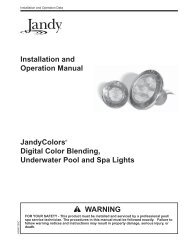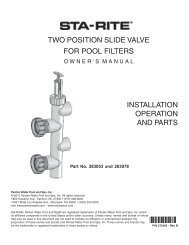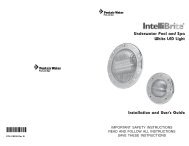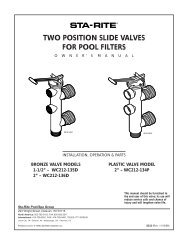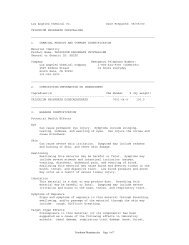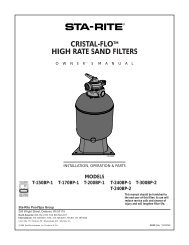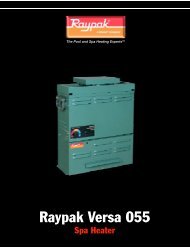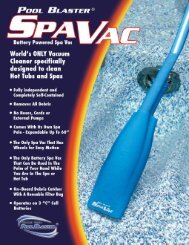Jandy LXi : installation and operation manual - Piscines et Spas ...
Jandy LXi : installation and operation manual - Piscines et Spas ...
Jandy LXi : installation and operation manual - Piscines et Spas ...
You also want an ePaper? Increase the reach of your titles
YUMPU automatically turns print PDFs into web optimized ePapers that Google loves.
<strong>LXi</strong> Pool/Spa Heater Installation <strong>and</strong> Operation Manual Page 177. If the gas supply pressure is less than required,check for undersized pipe b<strong>et</strong>ween the m<strong>et</strong>er <strong>and</strong>the heater, a restrictive fitting, or an undersizedgas m<strong>et</strong>er. Gas supply pressures to the heater arelisted in Table 6.Table 6. Gas Supply Pressure Requirements*Supply Pressure Minimum MaximumNatural Gas 5.0 inches W.C.(1.2 kPa)10.5 inches W.C.(2.6 kPa)LP GasManifold PressureNatural GasLP Gas11.0 inches W.C.(2.5 kPa)14.0 inches W.C.(3.5 kPa)Nominal2.5 inches W.C. (0.6 kPa)9.0 inches W.C. (2.2 kPa)NOTE The maximum inl<strong>et</strong> gas pressure must notexceed the specifi ed value. The minimum valuelisted is for the purpose of input adjustment. Referto Table 6.8. To connect the gas supply line to the heater’s gasvalve, make sure the steel elbow (supplied withthe manifold) is screwed into the inl<strong>et</strong> side of thegas valve. The heater is designed so that the gassupply line may enter through either side of theheater. Tighten the elbow until the desired orientationis achieved.CAUTIONDo not overtighten the elbow. Over tightening willcrack the gas valve. Do not use tefl on tape to wrapthe elbow threads.ATTENTIONNe serrez pas trop le coude. Vous risqueriez de fi s-surer la soupape de gaz. N’entourez pas le fi l<strong>et</strong>agedes coudes de ruban à joints.9. Before operating the heater, test the compl<strong>et</strong>e gassupply system <strong>and</strong> all connections for leaks usinga soap solution. Do not use an open flame.CAUTIONSome leak test solutions (including soap <strong>and</strong> water)may cause corrosion or stress cracking. Rinse thepiping with water after testing.ATTENTIONCertaines solutions d’essai d’étanchéité (y comprisl’eau <strong>et</strong> le savon) peuvent causer de la corrosionou de la fi ssuration. Rincez les tuyaux à l’eau aprèsl’essai d’étanchéité.4.2 Manifold PressureConfirm that gas supply pressure is correct. Ifthe gas supply pressure is less than required, checkfor undersized pipe b<strong>et</strong>ween the m<strong>et</strong>er <strong>and</strong> the heater,a restrictive fitting, or an undersized gas m<strong>et</strong>er. Gassupply pressures to the heater, when it is operating, arelisted in Table 6.CAUTIONManifold gas pressure for the <strong>LXi</strong> natural gas heatersshould be s<strong>et</strong> at 2.5" WC. Propane heatersshould be s<strong>et</strong> to 9" WC.ATTENTIONLa pression du collecteur de pression pour lessystèmes de chauffage au gaz naturel devrait êtrede 2.5'’ WC. Pour les sytèmes de chauffage au gazpropane devrait être de 9'’ WC.The manifold pressure may be checked by connectinga manom<strong>et</strong>er to the pressure port on the outl<strong>et</strong>side of the valve. The pressure will be zero when theheater is not running. When the heater is operating themanifold gas pressure should be 2.5" WC for naturalgas heaters <strong>and</strong> 9.0" WC for LP gas heaters.If the manifold pressure indicated above is notcorrect, check the gas train for possible problems.Check the m<strong>et</strong>er, gas line, gas fittings, <strong>and</strong> gas shut offfor under sizing. Check the gas valve inl<strong>et</strong> for excesspipe dope, if all is correct, then it may be necessary toadjust the gas valve regulator. To adjust the manifoldgas pressure, first remove the slotted cap next to theinl<strong>et</strong> pressure port on the inl<strong>et</strong> side of the gas valve.Under the slotted cap is a slotted plastic screw whichincreases the manifold pressure when turned clockwise<strong>and</strong> decreases the manifold pressure when turnedcounterclockwise. After measurements, <strong>and</strong> adjustmentsif necessary, have been made, make sure toreplace the 1/8" NPT gas valve plugs on the inl<strong>et</strong> <strong>and</strong>manifold pressure ports, <strong>and</strong> the cap on the manifoldpressure adjustment screw. It is extremely importantto replace these parts before leaving the <strong>installation</strong>.Failure to do so can result in damage to property or injuryor death. With the heater fi ring, the pressure mustbe within the range shown in Table 6. Also check thepressure with the heater off.4.3 Special Precautions for LP GasLP Gas is heavier than air <strong>and</strong> can therefore morereadily collect or “pool” in enclosed areas if provisionfor proper ventilation is not made. Installation of poolheaters in enclosed areas such as pits is not recommended.However, if such an <strong>installation</strong> is requiredbe sure to pay special attention to proper ventilationrequirements for LP gas. Locate heaters a safe distancefrom LP gas cylinders <strong>and</strong> filling equipment.Consult the National Fuel Gas Code (NFPA 54 / ANSIZ223.1, latest edition), the Natural Gas <strong>and</strong> PropaneInstallation Code in Canada (CAN/CSA B149.1, latestedition), <strong>and</strong> any other local codes <strong>and</strong> fire protectionauthorities about specific <strong>installation</strong> restrictions inyour area.




